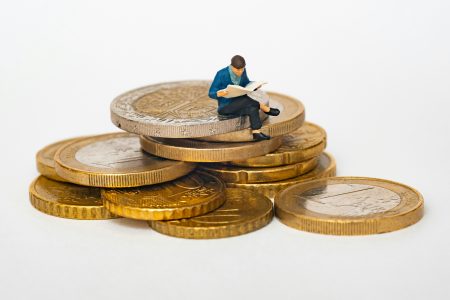Widgetized Section
Go to Admin » Appearance » Widgets » and move Gabfire Widget: Social into that MastheadOverlay zone
Government and the Economy
The views expressed are those of the author and do not necessarily reflect the views of ASPA as an organization.
By Troy A. Chavez
April 28, 2025

What’s the Economy?
Just as ambiguous as defining governance, the economy wears a shroud of gray and misty assumptions. We see it every day when we exchange money/currencies, start a business, pay taxes, buy foreign goods, support domestic products, or measure imports and exports (trade deficits), bond markets, stock markets and national debt. Money is involved.
Governance parlays into this system but is a component, not the body. Governments levy taxes, attack debt and deficits and manage imports and exports, yet they are not the business of the everyday economy. Consumers, financiers, businesses and corporations are the drivers.
The economy boils down to the distribution of resources—resources countries, individuals, governments and corporations/businesses have and divide. We have all heard the term “Banana Republic,” because it succinctly illustrates a country’s reliance on one product and export. Resources and how one parcels them out/in relates to a state’s economic capacity to supply goods and services for their populaces. We all need food to eat, products and services to buy and sell, bills to pay, children to feed and ills to be cured.
History and Theory
While there are myriad economic theories, Adam Smith, a classical thinker, believed in the “Invisible Hand.” This hand pushes people toward their “desires” and “wants.” Businesses provide these “wants” because of their “self-interest” in making money. Consumers then reward these businesses with their money and continued financial support. The “Invisible Hand” often moves governments to the side, relegating them to protecting property rights, enforcing the legality of contracts and machinating national defense apparatuses. Beyond that, the market, in this view, is better equipped at correcting itself than government.
The classical view emanates from the 1700s to 1800s and preludes the Industrial Revolution that constructed the modern world. Government intervention has waxed and waned since the “Invisible Hand” moved economic society forward. Intervention also looks different, too. Let’s provide a little perspective.
Marxist theorists (mid-late 1800s) believed the government should intercede in capitalism and transform it. Keynesians (1930s–1940s and onward) want an active government in terms of spending to stabilize the economy. Monetarists (1950s–1970s) believed in central monetary/currency control involving central banks.
Alternatively, Austrian economists (late 1800s–early 1900s) believe in virtually zero government intervention.
Moreover, supply-side economics (1970s–1980s and onward) desires low taxes, reduced regulations and limited government roles. This movement gained traction in the Ronald Reagan and Margaret Thatcher administrations. “Government is the problem,” Reagan declared. Government intervention has occurred in differing ways, but their actions also coincide with historical events spurring methodologies applicable to their concurrent era (e.g., 2008 market crash).
Case Study: Tariffs
Whether one desires less or more government intervention, government profoundly affects the economy nonetheless. However, political forces are mostly responsible for economic shifts and starts and stops. President Donald Trump’s tariffs are a perfect example.
Tariffs are taxes on imported goods and are used for varying reasons. Trump is seeking them for influence, better trade deals, intimidation and to bring manufacturing back to the United States. His tariffs are collected via the U.S. Customs and Border Protection (CBP) agency. This agency handles import tax collections, smuggling operations, enforces trade agreements and ensures safety, health and intellectual property rights of shipments are protected. It was instituted on March 1, 2003, as part of the reorganization of federal agencies under the U.S. Department of Homeland Security (DHS). The events of 9/11 shaped this administrative reorganization. Although the agency is new compared to the U.S.’s age, the act of collecting tariffs has always occurred (since 1780 even!).
Tariffs are taxes on companies importing foreign goods. Economists say the costs companies incur get thrust onto the consumers. Nevertheless, whether one is in favor or against them, tariffs are purposeful and directed toward benefiting homegrown industries. Albeit, a tariff is a tool and, just like a hammer, can be used for reckless and hurtful reasons.
Wrap-up
Economies are the needs and desires of a society. It is where one receives services, goods and products. These exchanges are monitored by governments and shaped by their policies. Presently, Trump’s tariffs—and the trade war broadly—have pushed consumers to secondhand items and deals to account for financial concerns.
Professor Sheng Lu, a director of graduate studies at the University of Delaware’s Department of Fashion and Apparel Studies, said in USA Today, April 25, 2025, secondhand clothing stores, like thrift stores, aren’t “totally immune to the tariff impact.” A continual trade war will have a searing impact on the fashion industry.
On children’s items, Lu said, “I’m afraid that the supply can be more limited.”
Trump’s tariffs are ongoing with “trade deals on the way,” per the administration. Trump, being the acting Commander in Chief of the U.S. government, is shaping not only the domestic economy but the global economy in long-lasting ways. We will feel their reverberating effects for generations to come via relationships, protectionist tendencies and lack of free trade. Governments shape our economic arenas whether they watch from the emperor’s perch or swathe in the gladiatorial ring as a referee or combatant. They are there.
Author: Troy Chavez, M.P.A. is a PhD candidate at Liberty University with a masters in public administration and works in government doing community relations. He can be reached at [email protected].


 (3 votes, average: 4.33 out of 5)
(3 votes, average: 4.33 out of 5)
Follow Us!